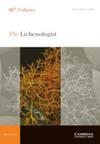A revision of the Rostania occultata (Collemataceae) complex in Fennoscandia
IF 1.4
4区 生物学
Q4 MYCOLOGY
引用次数: 2
Abstract
Abstract The Rostania occultata species complex (‘Collema occultatum s. lat.’) is revised in Fennoscandia and found to consist of four species, all epiphytes on deciduous trees: Rostania effusa A. Košuth., M. Westb. & Wedin sp. nov., R. occultata (Bagl.) Otálora et al., R. pallida A. Košuth., M. Westb. & Wedin sp. nov. and R. populina (Th. Fr.) A. Košuth., M. Westb. & Wedin comb. nov. Rostania effusa and R. pallida are newly described from humid habitats in old-growth boreal coniferous forests, usually with a mixture of deciduous trees, and from similar areas in the subalpine birch-dominated forests of Fennoscandia. Rostania effusa is characterized by apothecia with red-brown apothecium discs and an excipulum thallinum with a simple pseudocortex and cubic to oblong, muriform spores. Rostania pallida has apothecia with whitish to pale yellowish discs and an excipulum thallinum with a distinct cellular pseudocortex, and ellipsoid, muriform mature spores that are often constricted at the centre. A lectotype is designated for Collema quadratum J. Lahm ex Körb. The new combination Rostania populina is introduced for the species recognized until now as the variety Rostania occultata var. populina (Th. Fr.) Perlmutter & Rivas Plata. A key to the six species in Rostania s. str. is included.Fennoscandia中掩星花(Collemataceae)复合体的修订
摘要:在Fennoscandia中对Rostania occlultata物种复合体(“Collema occlultatum s.lat.”)进行了修订,发现其由四个物种组成,均为落叶树附生植物:Rostania effusa A.Košuth。,M.Westb.&Wedin sp.nov.,R.occlultata(Bagl.)Otálora等人,R.pallida A.Košuth。,M.Westb.&Wedin sp.nov.和R.populina(Th.Fr.)A.Košuth。,M.Westb.&韦丁梳。nov.Rostania effusa和R.pallida是新描述的,它们来自古老的北方针叶林中的潮湿栖息地,通常有落叶树的混合物,以及芬诺斯坎迪亚亚高山桦树为主的森林中的类似地区。Rostania effusa的特征是具有红棕色顶端古猿圆盘的顶端古猿和具有简单的假皮质和立方到长方形、鼠形孢子的切除体铊。苍白玫瑰具有带白色至淡黄色圆盘的顶端古猿和带明显细胞假皮质的切除体铊,以及通常在中心收缩的椭圆形、鼠形成熟孢子。为Collema quadratum J.Lahm ex Körb指定了一个选择型。新组合Rostania populina是为迄今为止公认的品种Rostania occlultata var.populina(Th.Fr.)Perlmutter&Rivas Plata而引入的。文中列出了六个品种的一个检索表。
本文章由计算机程序翻译,如有差异,请以英文原文为准。
求助全文
约1分钟内获得全文
求助全文
来源期刊

Lichenologist
生物-真菌学
CiteScore
2.90
自引率
14.30%
发文量
23
审稿时长
6.0 months
期刊介绍:
The Lichenologist is the premier scientific journal devoted exclusively to the study of lichens worldwide. As the leading forum for the dissemination of new concepts and topical reviews, The Lichenologist reaches more scientists concerned with the study of lichens and lichen symbionts than any other single journal. All aspects of lichenology are considered including systematics and phylogenetics; molecular biology; ultrastructure, anatomy and morphology; secondary chemistry, effects of pollutants and use as bioindicators; biogeography. In addition to standard length research papers, the journal also publishes Short Communications and Book Reviews. A monthly issue may occasionally be devoted to papers deriving from a symposium.
 求助内容:
求助内容: 应助结果提醒方式:
应助结果提醒方式:


